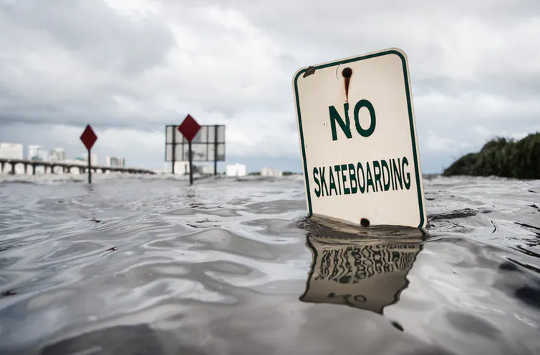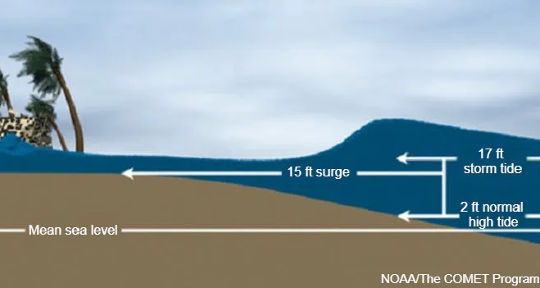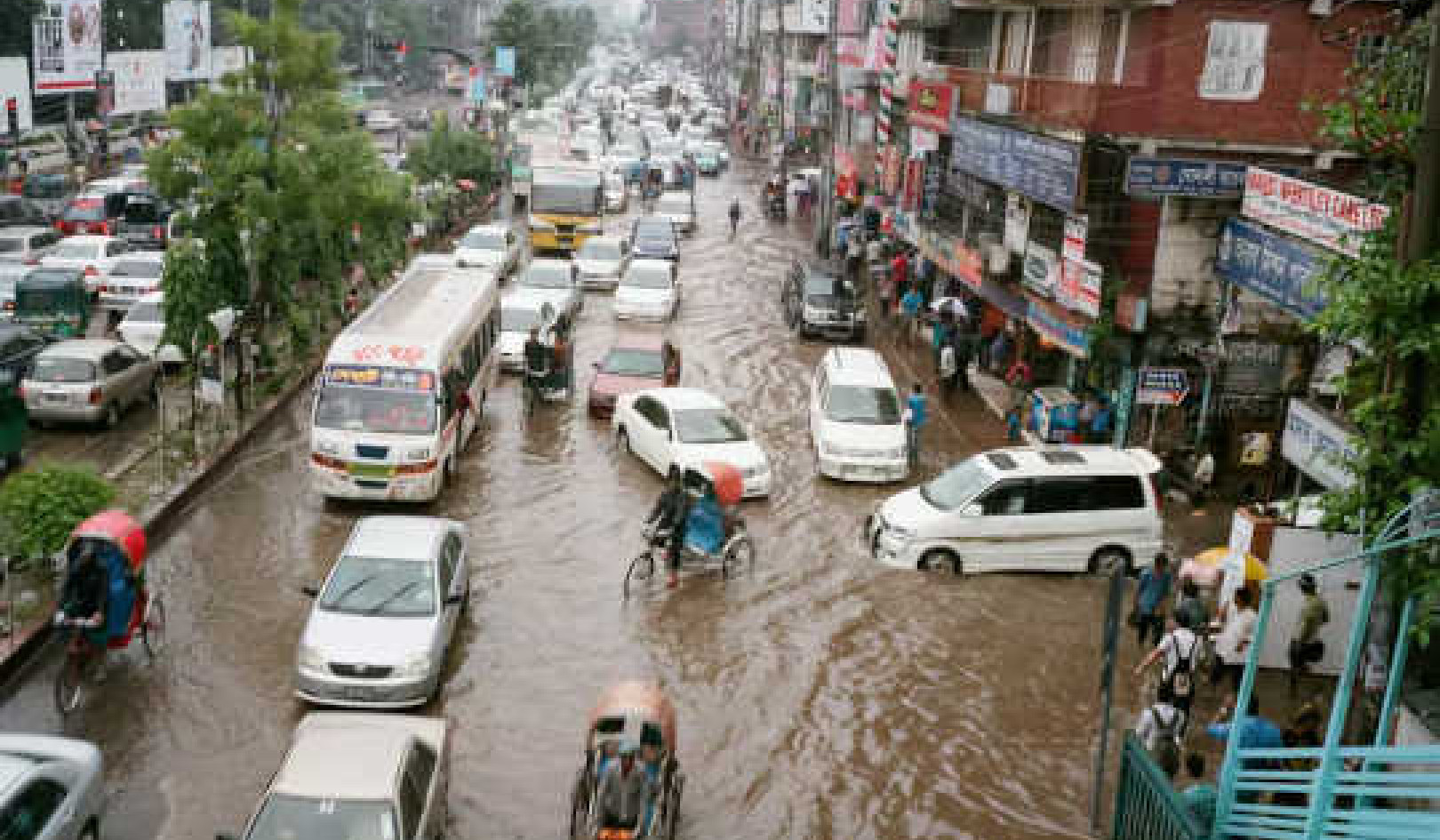
Storm surge can push water levels well above normal sea level during a hurricane. Sean Rayford/Getty Images
As Hurricane Sally headed for the northern Gulf Coast on Tuesday, September 15, 2020 forecasters warned of a potentially life-threatening storm surge, with water levels that could rise as high as 7 feet in some areas.
Of all the hazards that hurricanes bring, storm surge is the greatest threat to life and property along the coast. It can sweep homes off their foundations, flood riverside communities miles inland, and break up dunes and levees that normally protect coastal areas against storms.
But what exactly is storm surge?
What storm surge looks like from shore
As a hurricane reaches the coast, it pushes a huge volume of ocean water ashore. This is what we call storm surge.
This surge appears as a gradual rise in the water level as the storm approaches. Depending on the size and track of the hurricane, storm surge flooding can last for several hours. It then recedes after the storm passes.
Water level heights during a hurricane can reach 20 feet or more above normal sea level. With powerful waves on top of it, a hurricane’s storm surge can cause catastrophic damage.
What determines how high a storm surge gets?
Storm surge begins over the open ocean. The strong winds of a hurricane push the ocean waters around and cause water to pile up under the storm. The low air pressure of the storm also plays a small role in lifting the water level. The height and extent of this pile of water depend on the strength and size of the hurricane.
As this pile of water moves toward the coast, other factors can change its height and extent.
{vembed Y=TbHO1mWHKq4}
The depth of the sea floor is one factor.
If a coastal area has a sea floor that gently slopes away from the coastline, it’s more likely to see a higher storm surge than an area with a steeper drop-off. Gentle slopes along the Louisiana and Texas coasts have contributed to some devastating storm surges. Hurricane Katrina’s surge in 2005 broke levees and flooded New Orleans. Hurricane Ike’s 15- to 17-foot storm surge and waves swept hundreds of homes off Texas’ Bolivar Peninsula in 2008. Both were large, powerful storms that hit in vulnerable locations.
The shape of the coastline can also shape the surge. When a storm surge enters a bay or river, the geography of the land can act as a funnel, sending the water even higher.
Other factors that shape storm surge
Ocean tides – caused by the gravity of the moon and sun – can also strengthen or weaken the impact of a storm surge. So, it’s important to know the timing of the local tides compared to the hurricane landfall.
At high tide, the water is already at an elevated height. If landfall happens at high tide, the storm surge will cause even higher water levels and bring more water further inland. The Carolinas saw those effects when Hurricane Isaias hit at close to high tide on Aug. 3. Isaias brought a storm surge of about 4 feet at Myrtle Beach, South Carolina, but the water level was more than 10 feet above normal.
 How a storm surge and high tide add up to coastal flooding. The COMET Program/UCAR and National Weather Service
How a storm surge and high tide add up to coastal flooding. The COMET Program/UCAR and National Weather Service
Sea level rise is another growing concern that influences storm surge.
As water warms, it expands, and that has slowly raised sea level over the past century as global temperatures have risen. Freshwater from melting of ice sheets and glaciers also adds to sea level rise. Together, they elevate the background ocean height. When a hurricane arrives, the higher ocean means storm surge can bring water further inland, to a more dangerous and widespread effect.
This article has been updated with latest storm surge estimate for Hurricane Sally
About the Author
Anthony C. Didlake Jr., Assistant Professor of Meteorology, Pennsylvania State University
This article is republished from The Conversation under a Creative Commons license. Read the original article.
Related Books
Life After Carbon: The Next Global Transformation of Cities
by Peter Plastrik , John Cleveland The future of our cities is not what it used to be. The modern-city model that took hold globally in the twentieth century has outlived its usefulness. It cannot solve the problems it helped to create—especially global warming. Fortunately, a new model for urban development is emerging in cities to aggressively tackle the realities of climate change. It transforms the way cities design and use physical space, generate economic wealth, consume and dispose of resources, exploit and sustain the natural ecosystems, and prepare for the future. Available On Amazon
The future of our cities is not what it used to be. The modern-city model that took hold globally in the twentieth century has outlived its usefulness. It cannot solve the problems it helped to create—especially global warming. Fortunately, a new model for urban development is emerging in cities to aggressively tackle the realities of climate change. It transforms the way cities design and use physical space, generate economic wealth, consume and dispose of resources, exploit and sustain the natural ecosystems, and prepare for the future. Available On Amazon
The Sixth Extinction: An Unnatural History
by Elizabeth Kolbert Over the last half-billion years, there have been Five mass extinctions, when the diversity of life on earth suddenly and dramatically contracted. Scientists around the world are currently monitoring the sixth extinction, predicted to be the most devastating extinction event since the asteroid impact that wiped out the dinosaurs. This time around, the cataclysm is us. In prose that is at once frank, entertaining, and deeply informed, New Yorker writer Elizabeth Kolbert tells us why and how human beings have altered life on the planet in a way no species has before. Interweaving research in half a dozen disciplines, descriptions of the fascinating species that have already been lost, and the history of extinction as a concept, Kolbert provides a moving and comprehensive account of the disappearances occurring before our very eyes. She shows that the sixth extinction is likely to be mankind's most lasting legacy, compelling us to rethink the fundamental question of what it means to be human. Available On Amazon
Over the last half-billion years, there have been Five mass extinctions, when the diversity of life on earth suddenly and dramatically contracted. Scientists around the world are currently monitoring the sixth extinction, predicted to be the most devastating extinction event since the asteroid impact that wiped out the dinosaurs. This time around, the cataclysm is us. In prose that is at once frank, entertaining, and deeply informed, New Yorker writer Elizabeth Kolbert tells us why and how human beings have altered life on the planet in a way no species has before. Interweaving research in half a dozen disciplines, descriptions of the fascinating species that have already been lost, and the history of extinction as a concept, Kolbert provides a moving and comprehensive account of the disappearances occurring before our very eyes. She shows that the sixth extinction is likely to be mankind's most lasting legacy, compelling us to rethink the fundamental question of what it means to be human. Available On Amazon
Climate Wars: The Fight for Survival as the World Overheats
by Gwynne Dyer Waves of climate refugees. Dozens of failed states. All-out war. From one of the world’s great geopolitical analysts comes a terrifying glimpse of the strategic realities of the near future, when climate change drives the world’s powers towards the cut-throat politics of survival. Prescient and unflinching, Climate Wars will be one of the most important books of the coming years. Read it and find out what we’re heading for. Available On Amazon
Waves of climate refugees. Dozens of failed states. All-out war. From one of the world’s great geopolitical analysts comes a terrifying glimpse of the strategic realities of the near future, when climate change drives the world’s powers towards the cut-throat politics of survival. Prescient and unflinching, Climate Wars will be one of the most important books of the coming years. Read it and find out what we’re heading for. Available On Amazon
From The Publisher:
Purchases on Amazon go to defray the cost of bringing you InnerSelf.comelf.com, MightyNatural.com, and ClimateImpactNews.com at no cost and without advertisers that track your browsing habits. Even if you click on a link but don't buy these selected products, anything else you buy in that same visit on Amazon pays us a small commission. There is no additional cost to you, so please contribute to the effort. You can also use this link to use to Amazon at any time so you can help support our efforts.
























